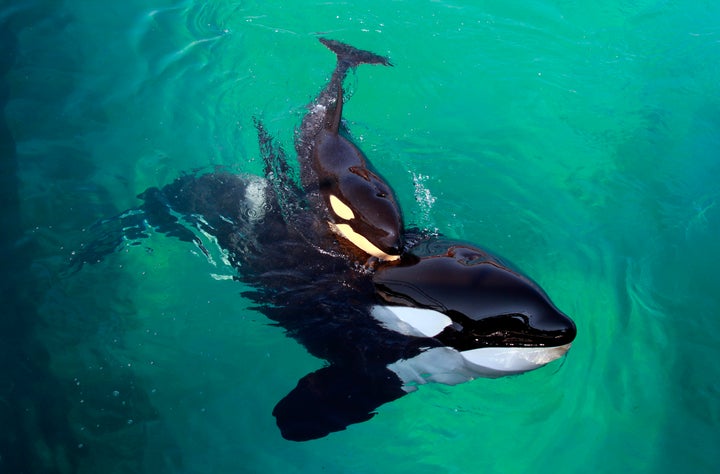Coercing animals like Wikie the orca to perform human behaviours such as counting and speaking is unnatural and could drive a worrying trend to turn wildlife into tourist attractions, campaigners have warned.
The 16-year-old killer whale’s communication skills were put to the test at her home at Marineland aquarium, in Antibes, where it was found she could mimic words such as “hello” and “Amy” and count “one, two, three”.
Although some wildlife campaigners have warned against such experiments, many animal behaviourists welcomed the revelation of Wikie’s communication skills. A study also found she could speak human words through her blowhole.

The experiments, carried out two years ago, have been reported in the journal Proceedings of the Royal Society B.
Although the researchers did not set out to test Wikie’s communication skills, the scientist who led the study believes basic “conversations” with her may one day be possible.
But lead scientist for the study, Dr Jose Abramson, from Complutense de Madrid University in Spain, warned: “You have to be careful about imposing our human concepts on animals. We will gain more if we try to understand the natural way each species communicates in its own environment than if we try to teach a human language.”
Killer whales both in the wild and in captivity have been observed copying dolphin calls and the barks of sea lions.
Wikie’s case is the latest example of animals being trained to adopt human characteristics, experts said.
“You can picture it now: ‘Pay to come to marine land and pay €40 to speak to Wikie the orca and say hello and she will say hello back.'”
- Samantha Goddard, Born Free
Chimpanzees and orangutans have been taught to use sign language, and earlier this week a video of a rat shown showering like a human raised animal welfare concerns.
Samantha Goddard, campaigns officer at Born Free, told HuffPost UK: “There’s this humorous thing, it makes people laugh, but it’s not natural, it’s not natural for them to look like us.”
She warned about the potential for such studies to one day become a tourist attraction.
“These animals that are kept in captivity it [a tourist show] just seems to be the next thing,” Goddard said.
“You can picture it now: ‘Pay to come to Marineland and pay €40 to speak to Wikie the orca and say hello and she will say hello back’, I can picture that.
“It’s kind of the next thing to make people feel that they are closer to these animals.”
Audio clip of Wikie repeating the word “hello”.
She added that the study had “no real value” as the animals were trained to behave a certain way in reward for treats, adding that captivity was about “control”.
“I don’t know how much the trainers think they are connecting to the animals but at the end of the day, these are intelligent animals so no doubt they are able to make an exact copy of the sound they are hearing, but they are not by any means understanding the meaning behind those sounds.”
But William Hughes, professor of evolutionary biology at the University of Sussex, said most scientific efforts were directed towards understanding how animals communicate with each other.
“The most interesting thing from the recent orca study... is not so much they were able to train them to communicate with us, but rather that it shows their capabilities, their cognitive capabilities, their language capabilities.
“Because it is quite remarkable that an animal can learn to mimic in the way it seems they managed to get their orca to do and it then follows that the reason they have evolved that ability is because they use that mimicking ability, that learning ability in the wild, and it’s probably key to how they learn and maintain their own individual dialects,” he said.
“It shows their capabilities, their cognitive capabilities, their language capabilities”
- Professor William Hughes, University of Sussex
Different groups of orca have different dialects which can be distinguished from one another.
Wild killer whales are known to live in groups with unique vocal “dialects” – learned sounds used for communication that are kept within a particular population and passed to future generations.
Experts see these differences as cultural and believe they demonstrate a high level of social intelligence.
Killer whales, both in the wild and in captivity, have also been observed copying dolphin calls and the barks of sea lions.
Audio clip of Wikie saying “one, two three”.
Dr Neil D’Cruze, technical expert for animals in the wild at World Animal Protection, warned against trying to make other species act like humans.
“There’s research to try and find out more about how sentient animals are, how their cognitive abilities work, how they interpret the world. That’s one thing,” he said.
“Another thing is when we then impose costumes, behaviour and activities just for our entertainment.
“That is just a whole different ballgame and that’s a real concern because if you look at really reputable facilities that do have animals in captivity - those genuinely involved in conservation or rescue work - generally speaking they have got guidelines in place that the animals shouldn’t be forced to perform unnatural behaviour.”
He added: “At what point does that kind of activity signify enrichment, where you are ensuring that the animal’s psychological welfare is met, and at what stage are you actually forcing harm.”
But Hughes argued: “We always have to be careful about anthropomorphising but the fact that animals have languages, ways of communicating with each other, there is nothing revolutionary about that concept.”
Dr Claudia Mettke-Hofmann, from the school of natural sciences and psychology at Liverpool John Moores University, said such studies can present animals in a “more interesting” light.
“They become more interesting in terms of intelligence, their problem solving ability, how they solve social problems, we can learn a lot from them so they become more interesting for us,” Mettke-Hofmann told HuffPost UK.
“I think it’s give and take. We obviously learn what the animals are capable of but the animals get a means to better communicate with us and tell us what they want,” she added.
Speaking about the reason why humans can connect with such images of animals exhibiting these familiar characteristics, D’Cruze said: “We just want to understand our own place in the world.
“We want to know what makes us human, what are the characteristics, what are the behaviours, what are the abilities and then how that relates to the rest of live on the planet?”
